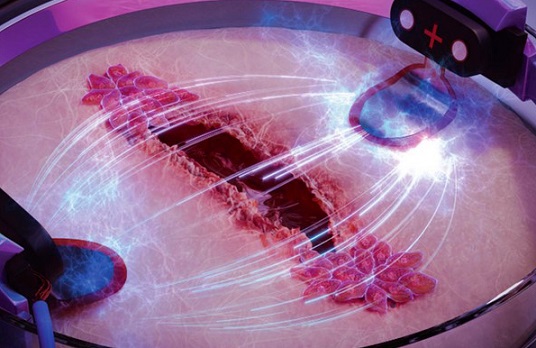LincRNA-EPS could revolutionize wound care for the elderly - New insights on skin healing
Nikhil Prasad Fact checked by:Thailand Medical News Team Jul 13, 2024 8 months, 2 weeks, 5 days, 15 hours, 45 minutes ago
Medical News: Understanding the Aging Skin Problem
As the population ages, a growing concern among researchers and healthcare professionals is the challenge of chronic wounds, which are notably common among the elderly. These include pressure ulcers, diabetic foot ulcers, and venous leg ulcers, affecting about 3% of individuals over the age of 65 in the United States. Chronic wounds not only cause discomfort and pain but also lead to substantial healthcare costs, with the US spending approximately $10 billion annually on wound care for the elderly.
 LincRNA-EPS could revolutionize wound care for the elderly - New insights on skin healing
LincRNA-EPS could revolutionize wound care for the elderly - New insights on skin healing
One significant factor in the impaired healing of these wounds is the diminished function of dermal fibroblasts, key cells in the skin responsible for wound repair. As people age, these cells show reduced proliferation, which hampers their ability to effectively heal wounds. This
Medical News report explores recent findings from a study conducted by researchers from the University of Tennessee Health Science Center-USA and Brown University-USA, revealing the potential of a molecule called LincRNA-EPS to enhance the proliferation of aged dermal fibroblasts and improve wound healing in the elderly.
What is LincRNA-EPS?
LincRNA-EPS (Erythroid ProSurvival) is a type of long intergenic non-coding RNA (lincRNA). Unlike typical RNA, which usually codes for proteins, lincRNAs play various roles in regulating gene expression and cellular functions. LincRNA-EPS, in particular, has been previously noted for its role in reducing inflammation and protecting cells from apoptosis (cell death).
The Study and Its Key Findings
The research team, led by Dr Junwang Xu from the Department of Physiology, College of Medicine, University of Tennessee Health Science Center, conducted an in-depth study to investigate the role of LincRNA-EPS in aged dermal fibroblasts. They isolated primary dermal fibroblasts from the skin of young (17-week-old) and aged (88-week-old) mice to compare their proliferation rates and gene expressions.
Reduced Expression in Aged Cells
Their results showed a significant decline in the expression of LincRNA-EPS in aged dermal fibroblasts compared to those from younger mice. This reduced expression was correlated with decreased levels of Cyclin D1 (CCND1), a critical regulator of the cell cycle, and consequently, reduced cell proliferation.
Overexpression Promotes Healing
To test the potential therapeutic effects, the researchers overexpressed LincRNA-EPS in aged dermal fibroblasts using plasmid transfection. Remarkably, this overexpression led to an upregulation of CCND1 and a significant increase in cell proliferation. The study demonstrated that LincRNA-EPS promotes cell proliferation by sequestering miR-34a, a microRNA known to inhibit CCND1 and induce cellular senescence.
Mechanisms Behind LincRNA-EPS Action
The study's detailed analysis revealed t
hat LincRNA-EPS acts as a molecular sponge for miR-34a, reducing its availability to target and inhibit CCND1. By doing so, LincRNA-EPS alleviates the inhibitory effects of miR-34a on cell proliferation. This regulatory mechanism underscores the potential of LincRNA-EPS to enhance the proliferative capacity of aged dermal fibroblasts, which is crucial for effective wound healing.
Implications for Future Therapies
The findings suggest that targeting LincRNA-EPS could offer a novel therapeutic strategy for improving wound healing in the elderly. By restoring the expression of LincRNA-EPS or modulating its interaction with miR-34a, it might be possible to enhance the regenerative capacity of aged dermal fibroblasts and accelerate wound healing.
Conclusion and Future Directions
This study opens new avenues for research and potential treatments aimed at addressing age-related wound healing impairments. The identification of LincRNA-EPS as a key regulator in dermal fibroblast function highlights its therapeutic potential. Future studies should focus on preclinical evaluations to assess the efficacy and safety of LincRNA-EPS-based interventions before considering clinical applications.
The study findings were published in the peer-reviewed journal: International Journal of Molecular Sciences.
https://www.mdpi.com/1422-0067/25/14/7677
For the latest on wound healing, keep on logging to Thailand
Medical News.
Read Also:
https://www.thailandmedical.news/news/herbs-and-phytochemicals-malaysian-scientists-using-cassia-alata-to-revolutionize-wound-healing
https://www.thailandmedical.news/news/medical-news-uk-study-find-that-casein-peptides-found-in-milk-aids-in-wound-healing
https://www.thailandmedical.news/news/researchers-discover-epigenetic-enzyme-that-can-aid-in-diabetic-non-healing-wounds
